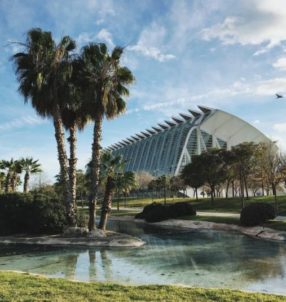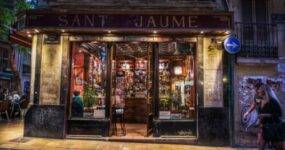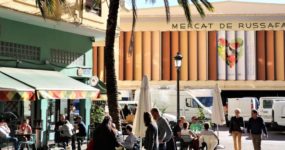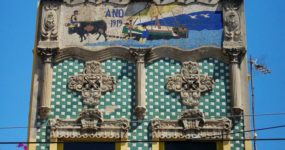Located in Turia Garden of Valencia, the Ciudad de las Artes y las Ciencias offers a day out that is full of activities. Whether you’re planning to stroll along the 2-kilometre stretch of futuristic sites, or you want to enter one of the buildings for a fascinating exhibition or event, this is a must-visit spot in Valencia. In contrast to the historic centre, the City of Arts and Sciences paradoxically provides visitors a feeling of living in the future. These striking buildings, which were constructed during the late 90s to early 00s, are the works of architects Santiago Calatrava and Félix Candela. Tickets to enter the l’hemisfèric, the Science Museum and l’Oceanogràfic can be bought combined or separately. So, be sure to plan your day well so you can make the most of your visit!
L’hemisfèric is a 3D cinema, with a 900-metre concave screen which presents numerous 45-minute films daily. These films tend to be educational and act as an excellent sit-down break during a full day of walking and exploring. L’hemisfèric was the first building to be opened to the public in 1998 and has an oval-shaped roof that is over 100 metres long. It is like no other cinema, so don’t miss out on a truly unique experience.
One of the more recent buildings in the City of Arts and Sciences is the Palau de les Arts. This is a spot where visitors can watch operas, classical and pop and flamenco concerts and dance shows in a breath-taking environment. Its innovative stage of 1500m2 is equipped with portable platforms and interchangeable sets, which make shows here truly spectacular.
On my trip around the City of Arts and Sciences, I visited the Science Museum. Their rule: forbidden not to touch. The world of technology and science is taught through interactivity, allowing the visitor to have a fully immersive experience. The museum encourages curiosity and critical thinking on a range of scientific and technological movements. On the first floor, you will find a giant sculpture representing DNA as well as permanent exhibitions. The second floor is called “The Legacy of Science” where you can learn about the lives of famous scientists like Santiago Ramon y Cajal, Severo Ochoa and Jean Dausset. On the final floor, you will see a “forest of chromosomes” and all-things space related, including ‘Mars: The Conquest of a Dream’. This floor was the most engaging for me. Here, you can enjoy learning about contagion, from catching viruses to yawning and laughter. The Mars exhibition explores the red planet in-depth. It encourages debates about the challenges of human colonisation and provides a variety of cultural, historical and, of course, scientific perspectives of the planet.
After the science exhibition, I strolled along l’umbracle; a massive, open-access garden. This covers more than 17,000m2 of typical Mediterranean plants and contemporary sculptures. During the summer, Terraza Mya opens its doors to visitors so that they can have a drink under the stars and moon.
Towards the end of the 2km futuristic stretch is l’Oceanogràfic. This is an avant-garde structure and was designed by architect Félix Candela and the structural engineers Alberto Domingo and Carlos Lazaro. It is Europe’s largest aquarium with seven marine environments and 500 different species, including dolphins, sharks, penguins, walruses, belugas, sea lions and seals. However, the ethical conundrum behind visiting an aquarium was one of my big concerns. Fear-not, I have done some research on Oceanogràfic’s ethical commitments. Given Valencia’s close relationship with the sea, it strives to promote the conservation of seas and oceans as well as their inhabitants. It regularly provides educational projects and carries out research to raise awareness about the environment of different marine ecosystems. In July 2020, l’Oceanogràfic obtained the Humane Certified seal, demonstrating its ethical commitment to marine mammals. The American Humane Conservation programme devotes itself to the verification of welfare, well-being and humane treatment of animals found in aquariums, zoos, and conservation centres around the world. If you are concerned about the ethical dilemma of visiting an aquarium, know that l’Oceanogràfic is one of the most animal-friendly aquariums in the world!
In this ultra-modern city, there is plenty to do. From animal-lovers to the future artists and scientists of the world, this multi-faceted space will never become obsolete.
Report by Sabina Redfern
Article Copyright ‘24/7 Valencia’
photo copyright Sabina Redfern/ ’24/7 Valencia’
Address: Av. del Professor López Piñero, 7, 46013, Valencia
Website: https://www.cac.es/en/home.html
Related Post
This site uses Akismet to reduce spam. Learn how your comment data is processed.

























Leave a comment